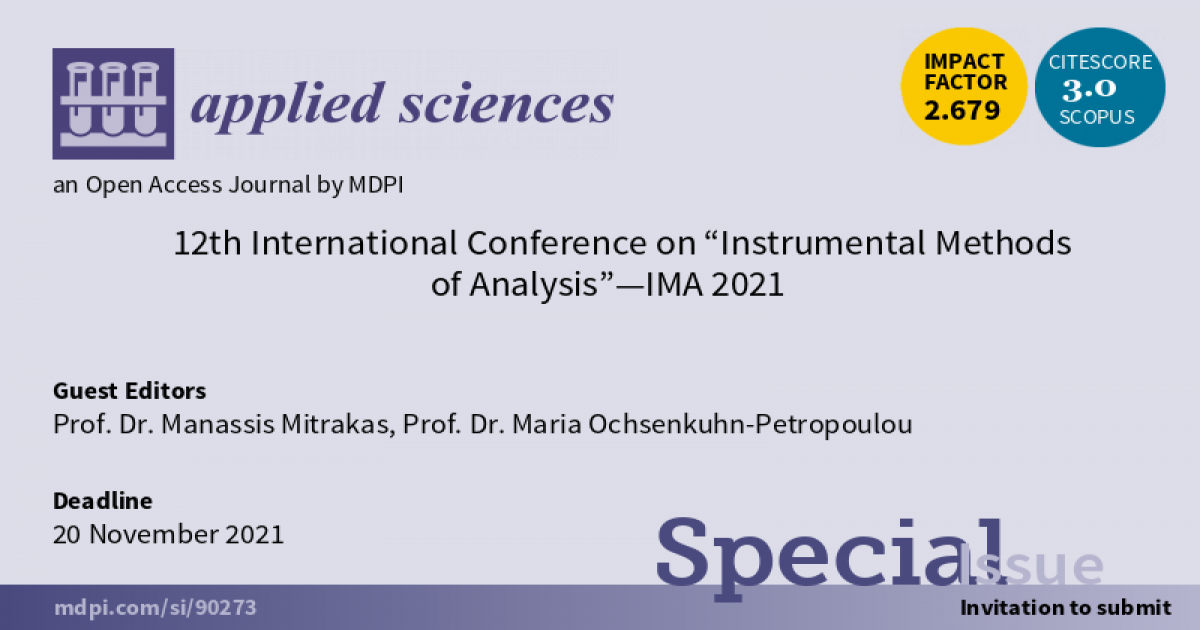12th International Conference on “Instrumental Methods of Analysis”—IMA 2021
A special issue of Applied Sciences (ISSN 2076-3417).
Deadline for manuscript submissions: closed (20 November 2021) | Viewed by 9186

Special Issue Editors
Interests: wastewater treatment; activated sludge processes; water quality and treatment; analytical chemistry; removal of toxic parameters from water; chemical engineering
Interests: utilization of industrial by-products in laboratory and pilot plant scale; recovery of rare earth elements and in particular of scandium from bauxite residue; speciation of metals and metalloids; preparation and characterization of superconducting powders and coatings; aerosol research in atmosphere; aerosol emissions from car catalysts exhaust and from burning of biomass; quality control of surface water and groundwater using modern analytical techniques
Special Issues, Collections and Topics in MDPI journals
Special Issue Information
Dear Colleagues,
The 12th International Conference on “Instrumental Methods of Analysis” (www.ima2021.gr), organized by the Aristotle University of Thessaloniki and National Technical University of Athens, provides the opportunity for high-level analytical scientists from all around the world to promote their relevant research.
Following the conference, the journal Applied Sciences will organize a Special Issue, which will publish papers focusing on new concepts, instruments, methods, systems, and applications in the area of modern chemical analysis, and more specifically, in the topic specified below:
- Spectrometric and electrometric analysis;
- Chromatographic, mass spectrometric, microscopic and thermal analysis methods;
- Proteomics, metabolomics, metallomics and elemental speciation analysis;
- Chemical and biosensors;
- Field analysis—mobile analytical instruments;
- Miniaturized analytical systems (lab-on-a-chip), micro- and nanofluidics;
- Immunoassays, electrophoretic separation techniques;
- Sampling techniques and strategies;
- Robotics and automation;
- Quality control–quality assurance in analysis;
- Metrology;
- Data processing and chemometrics;
- Environmental analysis;
- Biomedical (ecotoxicological, clinical) and pharmaceutical analysis;
- Food analysis;
- Materials analysis (nanomaterials, smart/advanced materials, surface analysis);
- Archaeometry.
Special sessions focused on aerosol metrology (supported by EU Project AEROMET II), advanced X-ray techniques (supported by the European X-ray Spectrometry Association) and virus spread analytics are organized within the frame of IMA-2021.
Prof. Dr. Manassis Mitrakas
Prof. Dr. Maria Ochsenkuhn-Petropoulou
Guest Editors
Manuscript Submission Information
Manuscripts should be submitted online at www.mdpi.com by registering and logging in to this website. Once you are registered, click here to go to the submission form. Manuscripts can be submitted until the deadline. All submissions that pass pre-check are peer-reviewed. Accepted papers will be published continuously in the journal (as soon as accepted) and will be listed together on the special issue website. Research articles, review articles as well as short communications are invited. For planned papers, a title and short abstract (about 100 words) can be sent to the Editorial Office for announcement on this website.
Submitted manuscripts should not have been published previously, nor be under consideration for publication elsewhere (except conference proceedings papers). All manuscripts are thoroughly refereed through a single-blind peer-review process. A guide for authors and other relevant information for submission of manuscripts is available on the Instructions for Authors page. Applied Sciences is an international peer-reviewed open access semimonthly journal published by MDPI.
Please visit the Instructions for Authors page before submitting a manuscript. The Article Processing Charge (APC) for publication in this open access journal is 2400 CHF (Swiss Francs). Submitted papers should be well formatted and use good English. Authors may use MDPI's English editing service prior to publication or during author revisions.
Keywords
- food analysis
- environmental analysis
- materials analysis
- biomedical and pharmaceutical analysis
- novel analytical methods
- sampling techniques






